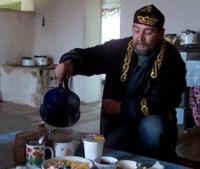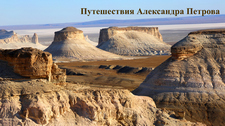Вы здесь
Legend of Karaman ata.

Stories about Holy Places of Mangistau.
"A Pot with a Cast Iron Pot Decided to Fight!
Without thinking, we went - we lost our way.
Now, you yourself are gaping - you are bypassed.
Throw out the bad thoughts from your memory!
You shot an arrow at a high mountain beyond your strength!
On your very first campaign, they took a lot of cattle from you;
If you ask me? I will say: "There is no sin in that!"
Throw out the bad thoughts from your memory!
Muhammad-Safa says: "I will give you advice!"
Believe my words, submit quickly!
I saw everything myself, you have nowhere to go.
Throw out the bad thoughts from your memory!
Appeal of Muhammad-Safa to Adayevtsy in 1870, "Collection of information about Caucasian mountaineers". Legends of Adayevtsy about saints of Hanafi sect, who lived and died in Mangyshlak". Proposed stories are written from words of Kafar Karadzhigitov, Bik-Bulat Yesekenov and mullah Khodja-Berdy. Issue VII. Tiflis. 1873.
Funeral and Cult Architecture of Mangyshlak.
Yesen ata had only one son, named Karaman ata, who was like his grandfather in everything, performed many miracles, built a mosque. After his death, he was buried near the mosque. The grave of Karaman ata is highly revered. Mostly, they swear an oath on it by name.
Once upon a time, between two clans that roamed Mangistau, there was a dispute over an important matter. It was decided, to complete the matter, that one hundred people, on the one hand, should take an oath on the grave of Karaman ata.
They took it, although their cause was unjust. When they had gone a hundred steps and mounted their horses to go home, suddenly thunder was heard, like a cannon shot, their faces turned black, all one hundred fell from their horses and died.
One woman lost her scarf, a cow ate it, not knowing about it, she suspected her neighbor of theft and demanded from her a cleansing oath, on the grave of Karaman ata. Both went there, and the suspected woman swore an oath of innocence.
When she returned home, she saw that a dead cow was lying near the kibitka, her belly had burst and the missing scarf was visible from it. There have been many similar cases, which is why everyone is convinced that anyone who has falsely sworn in the name of Karaman ata will certainly be punished.
Authority:
"Collection of information about Caucasian highlanders". Legends of Adaevites about saints of Hanafi sect who lived and died in Mangyshlak". Proposed stories are written from words of Kafar Karadzhigitov, Bik-Bulat Yesekenov and Mullah Khodja-Berdy. Issue VII. Tiflis. 1873.
There is another legend about Karaman Ata.
The legend, preserved among the people, says that once upon a time there lived two brothers - Akman and Karaman. They were famous for their great authority among the people and were considered saints. But one day they quarreled with Khoja Akhmet Yassavi.
After the quarrel, the brothers took their fellow tribesmen to the west, to Mangistau, and settled there. Among the residents of Mangistau, there are many stories and legends about the strength and power of Karaman Ata. Where Karaman Ata first stood on his feet, where he began to spread knowledge, there is now a necropolis of the same name, where a purifying oath is given in the name of Karaman Ata.
This land resolved contentious issues between peoples and clans, when irresolvable disputes between them threatened to turn into bloodshed. It was here that internecine wars ceased, and everyone received satisfaction. The battle axes (naiza) raised against each other were lowered down, the naked swords thirsting for blood, ready to rush into battle, were put back into their sheaths.
The fire of slander and gossip died down, the faces of the guilty darkened, and a wide road of life opened up before the innocent people. However, no one was proud of their victory, and did not boast of their success. Only before the greatness of the great Kudret (Almighty) did they bow their heads.
Therefore, not everyone dared to come to the grave of the saint (aulie) and ask him for justice. When the respected aksakal lowered his head in confusion, when no one listened to the words of the bey endowed with unlimited power, and the words were thrown to the wind, only then did people dare to come here.
They say that once the Turkmens and the Adays argued among themselves. In order to avoid bloodshed and end the dispute peacefully, they came to the grave of Karaman ata. At that time, it was customary for the Kazakhs to bet on the only son of one of the most famous people.
The choice fell on Koshan, the only son of the famous batyr Kozha-Nazar. To resolve the dispute, Beket ata was called in. Beket ata put 9-year-old Koshan on a black horse, stuck an awl into the saddle and said:
- "Oh, Karaman ata, if we are wrong, punish us, if the black one is wrong, punish the black one."
Then the horse fell dead, and the awl itself flew off several meters. When the little boy began to fall along with the horse, Beket ata managed to catch him.
- "Beket, you took the side of your blood relatives, we do not agree with you!" the Turkmens grumbled.
- "Then tomorrow at the same time we will meet in the holy place of Shekepar (Sheikh-Kubira)," said Beket ata and immediately turned into a white swan and flew up into the sky.
Amazed by the miracle that happened before their eyes, the Turkmens admitted their mistake and asked the aulie for forgiveness.
Authority:
Murat Kalmenov. "Underground mosques of Mangistau. Almaty. Publishing house "Orkhon". 2009. 160 p.
Name Karaman is often encountered in Kazakh and Karakalpak tales and legends, but none of these characters belong to the class of khojas, from whose ranks religious ministers usually emerged. Thus, in one Kazakh tale, this name is borne by a one-eyed giant-cannibal, whom the batyr Issim outwitted and killed.
In the Karakalpak legend, Karaman is a greedy and evil Turkmen bai, who was cursed by the sheikh for slandering and insulting Khoja Akhmed Yasawi and turned into a man-eating dog by the sheikh. Apparently, these characters cannot have anything in common with the pious Karaman ata, who, according to popular legend, is considered the holy father of the aulie.
The Turkmen legend says that at that time among the Turkmens lived two brothers - Akman and Karaman. They, as saints, enjoyed great authority among the people. After a quarrel with Khoja Akhmed Yasawi, they led their relatives - the Samyrs to the west, to Mangyshlak.
Commenting on this version of the legend, researcher A. Dzhikiyev writes:
- "In these legends, along with some fictitious ones, they tell about events that took place approximately in the XIIIth - XIVth centuries, when part of the Oguzes left the lower reaches of the Syr Darya. On Mangyshlak there is a place called Karamanly with a well of the same name."
The version of the legend recorded by A. Dzhikiyev reflects the historical fact of the migration of part of the Oguzes-Turkmens to Mangyshlak, but it turns out to have a large gap in time between the quarrel of the Turkmens with Khoja Akhmed Yasawi and their migration of one and a half to two centuries, which is probably not the case.
The quarrel between them could have occurred during the life of Khoja Akhmed, who died in 1166. If so, then the migration of the Turkmens should have been no later than the end of the XIIth - beginning of the XIIIth centuries. In this case, the necropolis of Karaman-ata can be dated within the XIIIth century.
Authority:
M. Mendikulov. "Monuments of Folk Architecture of Western Kazakhstan". Alma-Ata, Oner, 1987.
Photos by:
Alexander Petrov.







